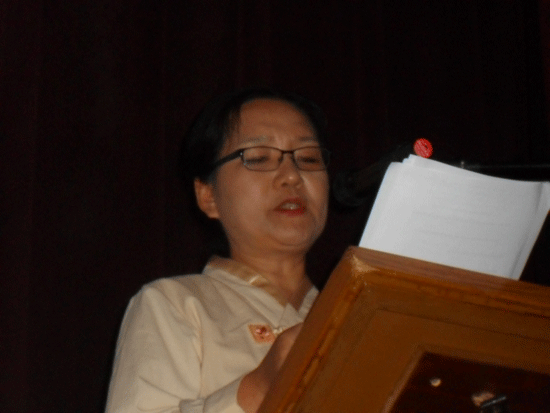<2010 NPT Review conference>
International Conference For a Nuclear Free, Peaceful, Just and Sustainable World
SPARK statememt (2010.5.1)

The significance of a peace treaty for the denuclearization of the Korean Peninsula
Solidarity for Peace and the Reunification of Korea
Distinguished delegates and friends,
Why did N. Korea develop nuclear weapons?
Since the Armistice Agreement was signed on July 27, 1953, the Korean peninsula has been in a state of war for the last 60 years. Only two months after the Armistice Agreement came into force, S. Korea and the United States signed the Mutual Defense Treaty and entered into a relationship of alliance. An alliance is premised on "a provisional war community" and its deliberate intention to perpetuate a state of armistice, in other words a state of war.
Article Ⅳ 60 in the Armistice Agreement made explicit that within three months after the Armistice Agreement becomes effective, a political conference should be held to settle through negotiation the question of the withdrawal of all foreign forces from Korea and the peaceful settlement of the Korean question. Therefore, the establishment of the S. Korea-U.S. alliance is a violation against Article Ⅳ 60 that called for an immediate transition from the state of armistice into a state of peace on the Korean peninsula.
In 1957, the United States deployed nuclear weapons on the Korean peninsula and this can be considered as the origin of the so-called nuclear crisis on the Korean peninsula. Although the U.S. claims that it had pulled out its nuclear weapons from S. Korea since the 1990’s, the U.S. has provided its nuclear umbrella to S. Korea and integrated the strategy of preemptive nuclear strike against N. Korea into its national security policy. For example, the U.S. has five operation plans applicable to both war-time and peacetime, such as OPLAN 5027 and 5029. Central to those OPLANs is the possible scenario of a nuclear war through U.S.' preemptive strike against N. Korea, aimed at the overthrow of the N. Korean regime. Particularly, OPLAN 5029, designed for possible military deployment to N. Korea even during peacetime, is a very provocative and offensive plan and as such it is an intervention against N. Korea’s domestic affairs and a violation of international law.
In 2002, the Bush government designated N. Korea not only as one of seven countries that are potential targets for preemptive nuclear strike but also as a 'chronically military concern' alongside Iraq, and then later overthrew the Iraqi regime by means of an illegal military invasion. This led to a decisive moment for N. Korea, which faced no other option but to develop nuclear weapons for self-defense. "The Atlantic Council" in its report on N. Korea (April, 2007) stated that the reason for N. Korea's development of nuclear weapons is mainly due to U.S. military threats against N. Korea. Furthermore, 85% of S. Korean people consider N. Korea’s nuclear weapons as a means of deterrence and self-defense against U.S. war threats. (Unification Research Institute, 2005)
How to achieve the dismantlement of N. Korea's nuclear weapons?
There is a cause and effect relationship between the S. Korea-U.S alliance and N. Korea's nuclear development. Thus, the dismantlement of N. Korea's nuclear weapons is directly related to the abolishment of the S. Korea-U.S alliance. N. Korea has already stated its conditions for the abolishment of its nuclear weapons as "the withdrawal of hostile policies against N. Korea, the abolishment of the U.S. nuclear umbrella for S. Korea, and the abolishment of the S. Korea-U.S. alliance" (February 3-7, 2009).
N. Korea's position is clearly different from the positions of other nuclear-weapon states that talk about the reduction or dismantlement of nuclear weapons by means of various nuclear weapons reduction negotiations. The N. Korean proposal for the denuclearization of the Korean peninsula is very simple, and it suggests an easy and feasible way to achieve the dismantlement of the N. Korean nuclear weapons. Furthermore, from a military point of view, N. Korea is in an inferior position in terms of its conventional arms capacity. Thus, it is conceivable that when N. Korea eliminates its nuclear weapons, there would no longer be a security risk for S. Korea and the United State to abolish their alliance on the Korean peninsula.
Establishing a peace treaty with N. Korea is the key to the denuclearization of the Korean peninsula and North-East Asia.
Concluding a peace treaty on the Korean peninsula will make a defining moment leading to the dismantlement of N. Korea's nuclear weapons. Concluding a peace treaty will bring an end to the continued state of war on the Korean peninsula and lead to the substantial elimination of the hostility inherent in the S. Korea-U.S nuclear alliance and eventually to the abolishment of the hostile alliance.
The continued state of war on the Korean peninsula for the for the last 60 years is an appalling violence unprecedented in modern world history. The urgent task for a peace treaty to end such a war is crucial to making peace on the Korean peninsula and North-East Asia, and further to building a peaceful, nuclear-free, global village. Denuclearization of the Korean peninsula through concluding a peace treaty will be a cornerstone for the establishment of a nuclear-weapon-free zone in North-East Asia, and also have ripple effects in facilitating the establishment of nuclear weapons free zones around the globe. Thank you.








